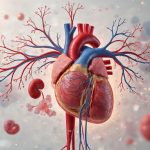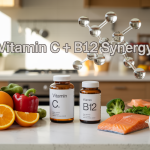Getting the right amounts of water and electrolytes each day keeps your body running smoothly, but most people don’t know how much they actually need.
This guide is for anyone who wants to understand their daily hydration and electrolyte needs—from athletes and parents tracking their family’s nutrition to older adults managing health conditions.
We’ll break down the official Dietary Reference Intakes for Water and Electrolytes so you can make informed choices about your daily intake. You’ll learn exactly how much water your body needs based on your age and activity level, discover which essential electrolytes like sodium and potassium your body can’t function without, and find out when special situations like pregnancy or intense exercise change your requirements.
Understanding Daily Water Requirements for Optimal Health
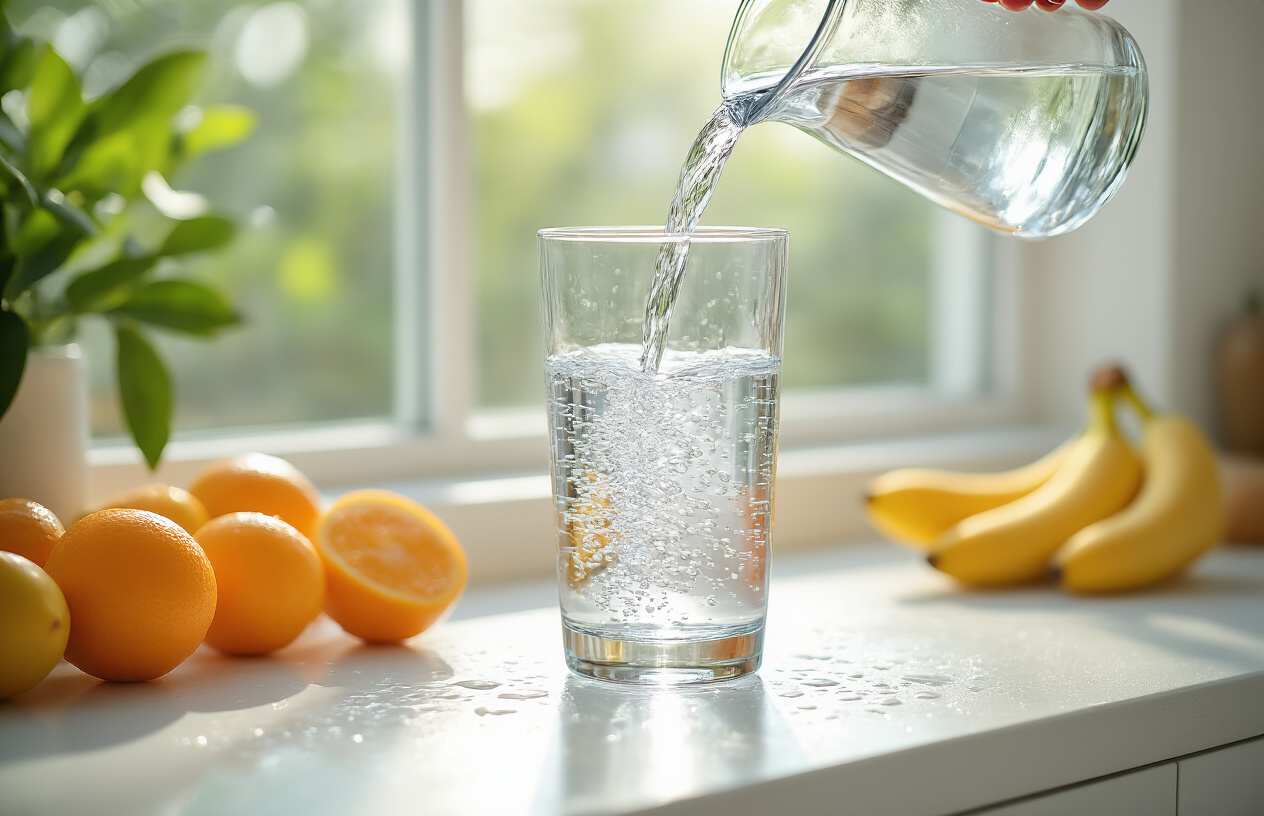
Calculate Your Personal Water Needs Based on Body Weight
Your body weight serves as the foundation for determining how much water you need each day. The most widely accepted formula suggests drinking 0.5 to 1 ounce of water per pound of body weight. For a 150-pound person, this translates to 75-150 ounces daily, or roughly 9-19 cups.
Here’s a simple calculation method:
| Body Weight | Minimum Daily Water | Optimal Daily Water |
|---|---|---|
| 120 lbs | 60 oz (7.5 cups) | 120 oz (15 cups) |
| 150 lbs | 75 oz (9.4 cups) | 150 oz (18.8 cups) |
| 180 lbs | 90 oz (11.3 cups) | 180 oz (22.5 cups) |
| 200 lbs | 100 oz (12.5 cups) | 200 oz (25 cups) |
Your baseline needs might lean toward the higher end if you’re physically active, live in a warm climate, or have a faster metabolism. People with larger muscle mass typically require more water since muscle tissue contains about 75% water compared to fat tissue’s 10-40%.
Age also plays a role in this calculation. Adults over 65 may need slightly more water per pound due to decreased kidney efficiency and reduced thirst sensation. Pregnant and breastfeeding women should add an extra 10-16 ounces daily to support increased blood volume and milk production.
Adjust Intake for Climate and Activity Level
Environmental conditions dramatically impact your water requirements. Hot, humid weather increases sweat production, while cold, dry conditions can lead to higher respiratory water loss through breathing. Air conditioning and heating systems create dry environments that boost your hydration needs.
Temperature adjustments follow these guidelines:
- Hot weather (above 85°F): Add 12-16 ounces per hour of exposure
- Cold weather (below 32°F): Add 4-8 ounces daily
- High altitude (above 8,000 feet): Increase intake by 16-24 ounces daily
- Air travel: Drink 8 ounces per hour of flight time
Physical activity creates the biggest variable in water needs. During exercise, you can lose 1-3 liters of fluid per hour through sweat. The American Council on Exercise recommends:
- Before exercise: 17-20 ounces, 2-3 hours prior
- During exercise: 7-10 ounces every 10-20 minutes
- After exercise: 150% of fluid lost (weigh yourself before and after)
Intensity matters too. Low-intensity activities like walking might only require an extra 12 ounces daily, while high-intensity training or prolonged activities can demand 36-48 additional ounces.
Recognize Signs of Proper Hydration Status
Your body provides clear signals about hydration status if you know what to look for. The most reliable indicator is urine color and frequency. Well-hydrated individuals produce pale yellow urine every 3-4 hours. Dark yellow or amber urine signals dehydration, while completely clear urine might indicate overhydration.
Physical signs of good hydration include:
- Skin elasticity: Pinch the skin on your hand’s back – it should snap back immediately
- Mucous membranes: Your mouth, nose, and eyes should feel moist, not sticky or dry
- Energy levels: Proper hydration maintains steady energy without afternoon crashes
- Mental clarity: Dehydration as mild as 2% can impair concentration and mood
Warning signs that require immediate attention:
- Dizziness or lightheadedness when standing
- Headaches that worsen throughout the day
- Constipation lasting more than two days
- Decreased urination (less than 4 times daily)
- Rapid heartbeat or breathing
Keep a simple hydration log for a few days, noting fluid intake, urine color, and how you feel. This helps identify your personal patterns and optimal intake levels. Remember that thirst is a late indicator of dehydration – by the time you feel thirsty, you’re already 1-2% dehydrated.
Essential Electrolytes Your Body Needs Daily

Sodium Requirements for Fluid Balance and Nerve Function
Your body runs on sodium like a car runs on oil – without enough, things start breaking down fast. The recommended daily intake sits between 1,500-2,300 mg for healthy adults, though most people consume way more than needed. Sodium acts as your body’s master regulator, controlling how much water stays in your cells and how much gets filtered out through your kidneys.
When sodium levels drop too low, you might experience muscle cramps, fatigue, and headaches. Your nerves rely on sodium to send signals throughout your body, making it essential for everything from heartbeats to muscle movements. However, too much sodium creates problems too – high blood pressure, water retention, and increased strain on your cardiovascular system.
Natural sources like sea salt, celery, and seaweed provide sodium alongside other beneficial minerals. Processed foods often contain excessive amounts, so reading labels becomes crucial for maintaining the right balance.
Potassium Intake for Heart Health and Muscle Contractions
Potassium works as sodium’s balancing partner, helping your body maintain proper fluid levels and supporting healthy blood pressure. Adults need approximately 3,500-4,700 mg daily, yet most people fall short of this target by significant margins.
Your heart muscle depends heavily on potassium for regular, strong contractions. Low potassium levels can trigger irregular heartbeats, muscle weakness, and fatigue. Athletes particularly need adequate potassium since intense exercise depletes levels through sweat.
Rich food sources include:
- Bananas (420 mg per medium banana)
- Sweet potatoes (540 mg per medium potato)
- Spinach (840 mg per cooked cup)
- Avocados (975 mg per whole fruit)
- White beans (1,000 mg per cooked cup)
Magnesium Needs for Energy Production and Bone Health
Magnesium participates in over 300 enzymatic reactions throughout your body, making it one of the hardest-working minerals you consume. Men need about 400-420 mg daily, while women require 310-320 mg, with pregnant women needing slightly more.
This mineral transforms food into usable energy at the cellular level. Without adequate magnesium, you might feel constantly tired, experience muscle twitches, or have trouble sleeping. Your bones store about 60% of your body’s magnesium, releasing it when blood levels drop too low.
| Food Source | Magnesium Content (mg) |
|---|---|
| Pumpkin seeds (1 oz) | 156 |
| Dark chocolate (1 oz) | 64 |
| Almonds (1 oz) | 80 |
| Spinach (1 cup cooked) | 157 |
| Black beans (1/2 cup) | 60 |
Calcium Guidelines for Strong Bones and Cellular Functions
Calcium does much more than build strong bones and teeth. This mineral helps your blood clot properly, enables muscle contractions, and allows nerves to transmit messages effectively. Adults typically need 1,000-1,200 mg daily, with postmenopausal women requiring higher amounts.
Your body absorbs calcium best when you consume it with vitamin D and spread intake throughout the day rather than taking large doses at once. Calcium works alongside magnesium and phosphorus to maintain bone density and prevent fractures as you age.
Dairy products remain excellent sources, but plant-based options work well too. Sardines with bones, leafy greens like kale and collard greens, and fortified plant milks provide substantial amounts. Your body stores 99% of its calcium in bones and teeth, using this reserve when dietary intake falls short.
Age-Specific Water and Electrolyte Guidelines

Infant and Toddler Hydration Requirements
Babies under 6 months get all their hydration needs from breast milk or formula – no additional water is necessary. Breast milk contains about 87% water, making it the perfect hydration solution for newborns. Once solid foods enter the picture around 6 months, small amounts of water can be introduced, typically 2-4 ounces per day.
Toddlers aged 1-3 years need approximately 4 cups (32 ounces) of fluid daily, which includes milk, water, and other beverages. Their kidneys are still developing, so they can’t handle large amounts of plain water at once. For electrolytes, toddlers require about 1,000mg sodium and 3,000mg potassium daily, easily met through a balanced diet including fruits, vegetables, and age-appropriate foods.
Signs of proper hydration in infants include regular wet diapers (6-8 per day for newborns), elastic skin when gently pinched, and active, alert behavior. Toddlers should have pale yellow urine and moist lips as indicators of adequate fluid intake.
Children and Adolescent Intake Recommendations
School-age children (4-8 years) need about 5 cups of fluids daily, while older children (9-13 years) require 7-8 cups. Active kids playing sports or spending time outdoors need additional fluids to replace what’s lost through sweat and increased breathing.
Adolescents have the highest fluid needs due to rapid growth spurts and increased physical activity. Boys aged 14-18 need approximately 11 cups daily, while girls need about 8 cups. During puberty, hormone changes affect fluid balance, making consistent hydration even more important.
| Age Group | Daily Fluid Needs | Sodium (mg) | Potassium (mg) |
|---|---|---|---|
| 4-8 years | 5 cups | 1,200 | 2,300 |
| 9-13 years | 7-8 cups | 1,500 | 2,500 |
| 14-18 years (boys) | 11 cups | 2,300 | 3,000 |
| 14-18 years (girls) | 8 cups | 2,300 | 2,300 |
Children and teens should focus on water and milk as primary beverages, limiting sugary drinks and sodas that can interfere with proper hydration and electrolyte balance.
Adult Daily Requirements by Gender
Adult women need about 8 cups (64 ounces) of fluid daily, while men require approximately 10 cups (80 ounces). These recommendations include all beverages and water from food sources, which typically contribute about 20% of daily fluid intake.
Electrolyte needs vary between genders due to differences in muscle mass and metabolic rate. Men typically require slightly higher amounts of sodium and potassium to support their larger body size and higher metabolic demands.
Daily Electrolyte Targets for Adults:
- Sodium: 2,300mg maximum (both genders)
- Potassium: 2,600mg (women), 3,400mg (men)
- Calcium: 1,000mg (both genders under 50)
- Magnesium: 310-320mg (women), 400-420mg (men)
Pregnancy and breastfeeding significantly increase fluid needs. Pregnant women should aim for 10 cups daily, while breastfeeding mothers need about 13 cups to support milk production and prevent dehydration.
Physical activity, climate, and overall health status can dramatically impact these baseline requirements. Adults living in hot climates or engaging in regular exercise may need 50-100% more fluids than sedentary individuals in temperate environments.
Senior Citizen Modified Needs and Considerations
Adults over 65 face unique hydration challenges that require special attention. Aging naturally decreases the body’s ability to conserve water, and the sensation of thirst becomes less reliable. Seniors often need the same fluid amounts as younger adults but may struggle to meet these requirements due to medication side effects, mobility issues, or fear of incontinence.
Kidney function typically declines with age, affecting electrolyte balance and the body’s ability to regulate fluid levels. Many common medications like diuretics, blood pressure medications, and antidepressants can impact hydration status and electrolyte balance.
Special Considerations for Seniors:
- Monitor urine color and frequency as hydration indicators
- Space fluid intake throughout the day rather than consuming large amounts at once
- Choose foods with high water content like soups, fruits, and vegetables
- Be aware that coffee and tea still contribute to hydration despite mild diuretic effects
- Consider electrolyte-enhanced beverages if taking medications that affect mineral balance
Chronic conditions common in older adults, such as diabetes, heart disease, and kidney problems, may require modified fluid and electrolyte intake. Seniors should work with healthcare providers to determine appropriate intake levels, especially when managing multiple medications or health conditions that affect fluid balance.
Regular monitoring becomes essential, as seniors may not recognize early dehydration symptoms like confusion, dizziness, or increased fall risk until dehydration becomes severe.
Special Circumstances Requiring Adjusted Intake

Pregnancy and Breastfeeding Increased Requirements
Growing a baby and producing breast milk puts extra demands on your body’s water and electrolyte stores. During pregnancy, blood volume increases by about 50%, and you’re literally building another human being who’s mostly made of water. The recommended water intake jumps to about 10 cups (2.3 liters) daily during pregnancy, compared to the standard 8 cups for non-pregnant women.
Your sodium needs also climb during pregnancy. The extra blood volume requires more sodium to maintain proper fluid balance, and your kidneys work harder to filter waste for both you and your baby. Potassium becomes equally important as it helps prevent pregnancy-related high blood pressure and supports proper muscle function during those intense months.
Breastfeeding mothers face even higher demands. Producing breast milk requires significant water – about 700-800ml of additional fluid daily beyond normal needs. That translates to roughly 13 cups (3.1 liters) of total daily water intake. Your body will literally pull water from your tissues to make milk if you’re not drinking enough, leaving you dehydrated and exhausted.
Calcium and magnesium requirements skyrocket during breastfeeding since these minerals transfer directly into breast milk. Without adequate intake, your body will leach these electrolytes from your bones to ensure your baby gets what they need. Many breastfeeding mothers experience muscle cramps and fatigue – often signs of electrolyte depletion rather than just sleep deprivation.
Athletic Performance and Exercise Recovery Needs
Athletes and active individuals face unique hydration challenges that go way beyond drinking more water. During intense exercise, you can lose 1-3 liters of fluid per hour through sweat, along with significant amounts of sodium, potassium, and other electrolytes. This loss varies dramatically based on factors like temperature, humidity, exercise intensity, and individual sweat rates.
Pre-exercise hydration starts 2-3 hours before activity with 17-20 ounces of water or sports drinks. During exercise lasting longer than an hour, you need 6-12 ounces of fluid every 15-20 minutes. The key is replacing both water and electrolytes – plain water alone can actually dilute your blood sodium levels during prolonged exercise, leading to a dangerous condition called hyponatremia.
Post-exercise recovery requires drinking 150% of the fluid lost during exercise. If you lost 2 pounds of body weight during your workout, you need to drink about 48 ounces of fluid to fully rehydrate. Sodium replacement becomes critical here – aim for 300-700mg of sodium per hour of exercise, especially in hot conditions or if you’re a heavy sweater.
Endurance athletes have learned that chocolate milk isn’t just a childhood treat – its 3:1 carbohydrate to protein ratio, plus natural electrolytes, makes it an excellent recovery drink. The combination helps restore muscle glycogen while replacing lost fluids and electrolytes more effectively than water alone.
Illness and Medical Condition Modifications
Fever, vomiting, and diarrhea can quickly throw your hydration status into chaos. For every degree of fever above 98.6°F, you need an extra 8 ounces of fluid daily. Vomiting and diarrhea create a double whammy – you’re losing fluids while simultaneously struggling to keep replacement fluids down.
During illness, electrolyte balance becomes even more important than total fluid intake. Vomiting depletes stomach acid (hydrochloric acid), while diarrhea flushes out intestinal fluids rich in sodium, potassium, and bicarbonate. Simple water won’t cut it – you need oral rehydration solutions that contain the right balance of electrolytes and glucose to help your intestines absorb the fluids effectively.
Certain medications dramatically affect fluid and electrolyte needs. Diuretics prescribed for high blood pressure or heart conditions can cause excessive loss of potassium and magnesium. ACE inhibitors may increase potassium retention, requiring dietary adjustments. Some antidepressants affect the hormone that regulates water retention, making you more susceptible to both dehydration and water intoxication.
People with kidney disease face complex fluid restrictions – too much water can overload already struggling kidneys, while too little can worsen kidney function. Diabetes adds another layer of complexity, as high blood sugar acts like a diuretic, pulling water from cells and increasing urination. Heart failure patients often need strict sodium restrictions to prevent fluid retention, but still need adequate potassium and magnesium for proper heart rhythm.
Food Sources That Meet Your Daily Requirements
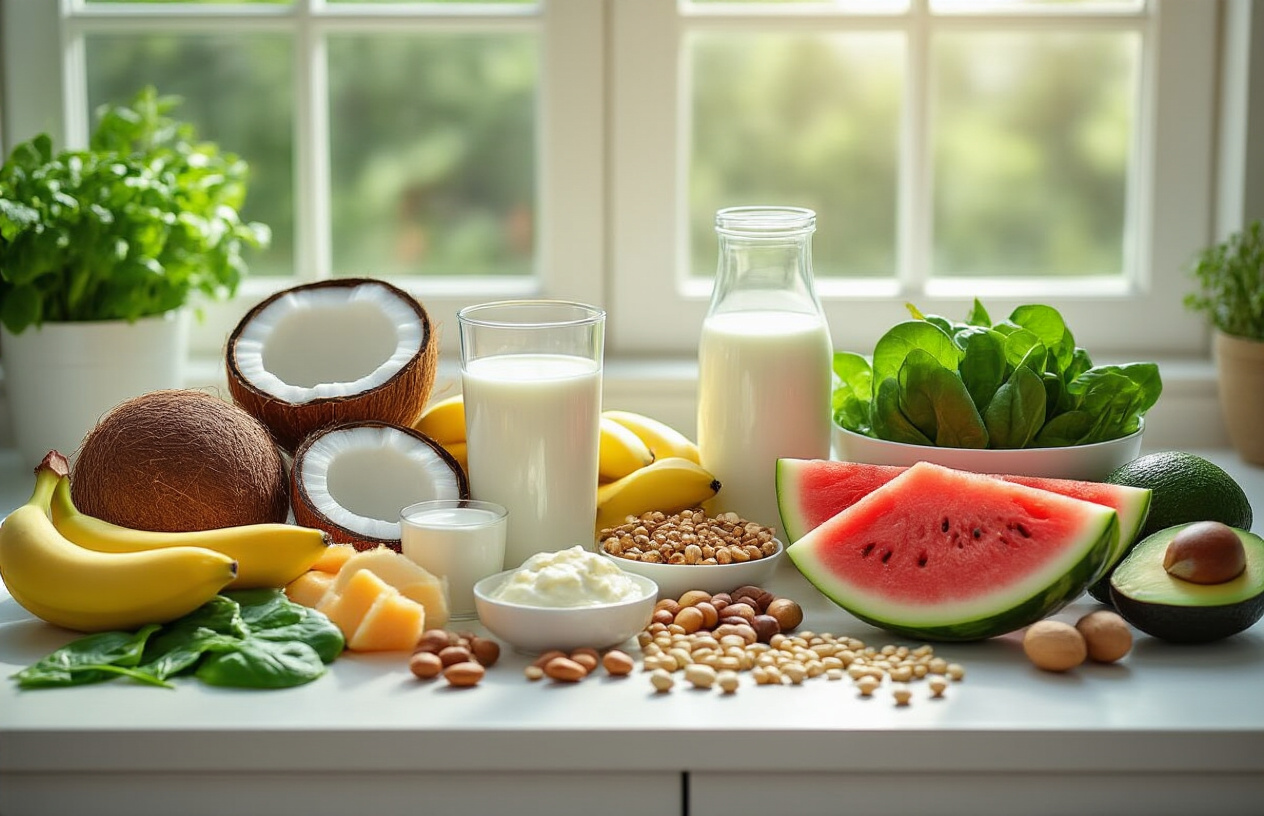
Hydrating Foods That Count Toward Water Intake
Water doesn’t just come from your glass or bottle. Many foods pack significant hydration power and contribute meaningfully to your daily fluid needs. Fruits and vegetables lead the charge, with some containing over 90% water by weight.
Watermelon tops the list at 92% water content, followed closely by cucumber (95%), lettuce (96%), and cantaloupe (90%). These foods not only hydrate but also provide vitamins, minerals, and fiber. Citrus fruits like oranges and grapefruits contain about 87% water, while apples and pears hover around 85%.
Dairy products contribute substantially to hydration needs. Milk contains roughly 87% water, while yogurt provides about 85%. Even seemingly solid foods help – tomatoes are 94% water, bell peppers reach 92%, and zucchini contains 95% water.
Broths and soups deserve special mention. Clear vegetable or chicken broth provides excellent hydration while delivering electrolytes and nutrients. Even heartier soups contribute significant fluid intake, though sodium content varies widely.
Experts estimate that food provides about 20% of total daily fluid intake for most people. This means if you need 2.5 liters daily, roughly 500ml comes from food sources. Planning meals around water-rich foods can significantly support your hydration goals while providing essential nutrients your body needs for optimal function.
Natural Electrolyte-Rich Foods for Daily Consumption
Your body requires a delicate balance of electrolytes – sodium, potassium, magnesium, and calcium – for proper muscle function, nerve transmission, and fluid balance. Whole foods provide these minerals in bioavailable forms that your body readily absorbs and uses.
Potassium Sources:
- Bananas (422mg per medium fruit)
- Sweet potatoes (542mg per medium potato)
- Spinach (839mg per cooked cup)
- Avocados (975mg per cup)
- White beans (1,189mg per cup)
Sodium Balance:
While most people consume excessive sodium, active individuals or those in hot climates may need strategic sodium intake. Natural sources include celery, beets, and sea vegetables like nori. However, most people should focus on potassium-rich foods to counterbalance typical high-sodium diets.
Magnesium Powerhouses:
- Dark leafy greens (spinach, Swiss chard)
- Nuts and seeds (pumpkin seeds, almonds)
- Dark chocolate (64mg per ounce)
- Quinoa (118mg per cooked cup)
Calcium Champions:
- Dairy products (milk, yogurt, cheese)
- Canned sardines with bones (325mg per 3.5oz)
- Kale (101mg per cooked cup)
- Tahini (119mg per 2 tablespoons)
Coconut water deserves special recognition as nature’s sports drink, containing 600mg potassium, 252mg sodium, and 60mg magnesium per cup. Fresh fruits and vegetables generally provide better electrolyte profiles than processed alternatives, supporting both hydration and overall health.
Supplement Options When Food Sources Fall Short
Sometimes whole foods alone can’t meet your hydration and electrolyte needs. Athletes training intensively, people working in extreme heat, those with certain medical conditions, or individuals with restricted diets may benefit from targeted supplementation.
Electrolyte Supplements:
Quality electrolyte powders or tablets can bridge gaps when food intake falls short. Look for products containing balanced ratios of sodium (300-700mg), potassium (200-300mg), and magnesium (50-100mg) per serving. Avoid options loaded with artificial colors, excessive sugar, or unnecessary additives.
Himalayan Pink Salt or Sea Salt:
Adding a pinch to water creates a simple electrolyte solution. These natural salts contain trace minerals beyond sodium chloride, though amounts vary significantly between brands.
Coconut Water Powder:
Convenient alternative to fresh coconut water, providing similar electrolyte content in shelf-stable form. Mix with water for instant natural hydration support.
Magnesium Supplements:
Since magnesium deficiency affects many people, standalone magnesium supplements (glycinate, citrate, or oxide forms) can support both electrolyte balance and muscle function.
When to Consider Supplements:
- Extended exercise sessions (over 60 minutes)
- Hot weather exposure
- Illness causing fluid loss
- Restrictive diets limiting food variety
- Signs of electrolyte imbalance (muscle cramps, fatigue, headaches)
Always consult healthcare providers before starting supplement regimens, especially if you take medications or have health conditions. Supplements work best alongside, not instead of, a varied diet rich in whole foods.
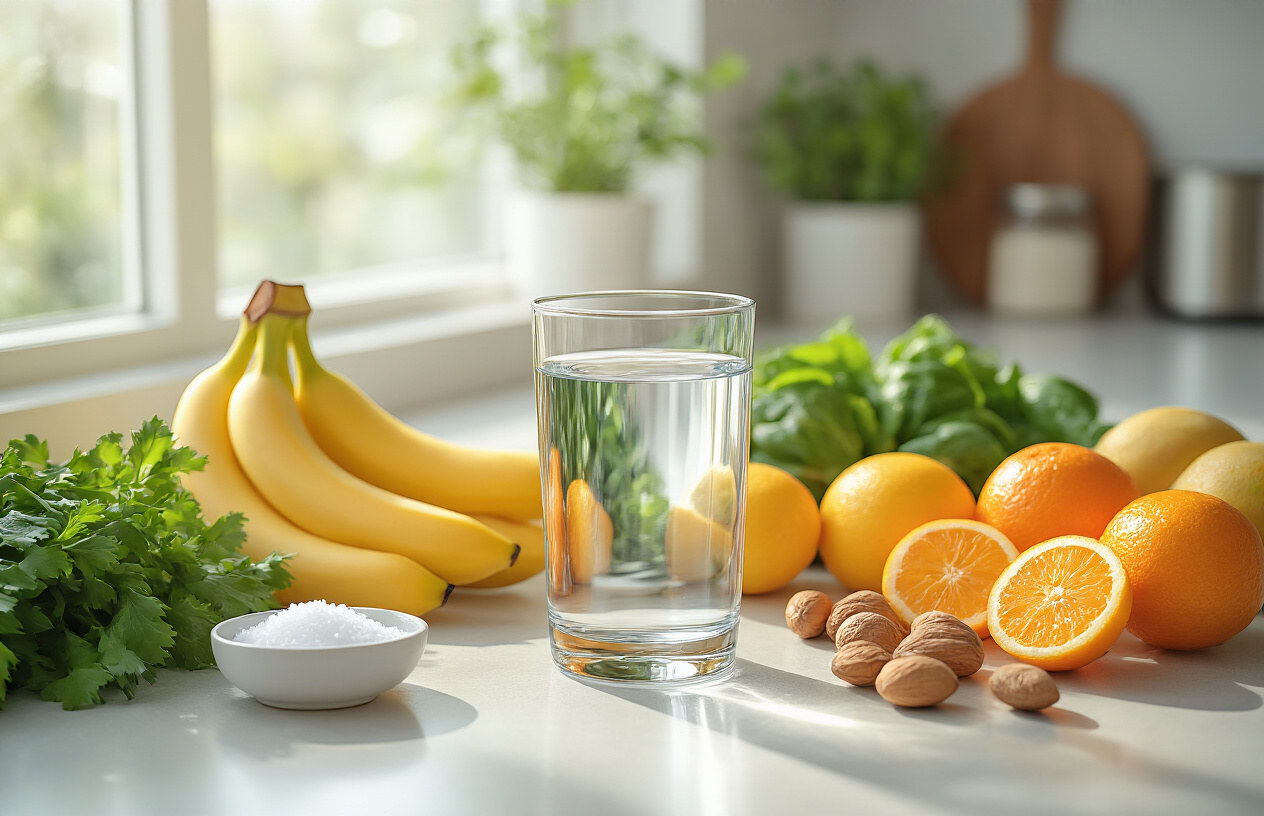
Getting enough water and electrolytes isn’t rocket science, but it’s one of those things that can make or break how you feel every day. Your body has pretty specific needs that change based on your age, activity level, and health situation. When you nail the right balance, you’ll notice better energy, clearer thinking, and just feeling more like yourself.
The good news is that meeting your daily requirements doesn’t have to be complicated. You can get what you need from a mix of plain water, foods you probably already eat, and maybe a sports drink here and there if you’re really active. Pay attention to what your body is telling you, adjust based on your life circumstances, and remember that staying hydrated is one of the simplest ways to take care of yourself. Start tracking your intake for a few days and see how small changes can make a big difference in how you feel.

